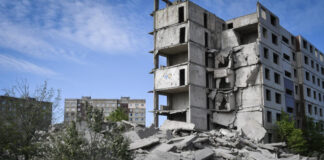Since the withdrawal of the last Ukrainian units engaged in Lyssytchansk, Russia and the separatist forces now control the province of Luhansk. Russian President Vladimir Putin has ordered his troops to continue their offensive in eastern Ukraine, as the Ukrainian army strengthens new lines of defense in the Donetsk region, where it still controls several major cities .
What are the objectives of the belligerents in this new phase which opens, more than four months after the outbreak of the war? Does Ukraine have the military means to withstand the intense Russian artillery fire? At what human and material cost?
Emmanuel Grynszpan, who has covered the conflict in Ukraine for Le Monde since the start of the offensive, and Cédric Pietralunga, journalist at the International Service of Le Monde, answered your questions.
Cédric Pietralunga: The question of the depth of human resources is essential in the war of attrition in which the Russians and the Ukrainians are engaged. According to most analysts, Ukraine has the advantage of having decreed general mobilization and of potentially having close to a million men. Conversely, Russia can only count on its active military, Vladimir Putin having renounced, for political reasons, to decree general mobilization: Moscow is not at war but is conducting a “special military operation”.
By February 24, Russia had amassed some 130,000 troops on Ukraine’s borders. Most have been or are engaged in combat, which limits turnover. Moscow’s recourse to Chechen auxiliaries or the Wagner, named after the paramilitary group, is another sign of this lack of reserves in the Russian army.
In this respect, the next few weeks will be interesting to follow: a large part of the Russian troops have been engaged since the beginning of the conflict, that is to say more than four months ago, and they need to breathe. Will it come through a break from fighting? Or will Vladimir Putin push his troops to complete the conquest of the entire Donbass, i.e. Donetsk Oblast after Luhansk?
Emmanuel Grynszpan and Cédric Pietralunga: This is most likely disinformation to cast doubt on the reliability of the Ukrainian army and disappoint public opinion in the countries supplying military equipment to Ukraine. If Caesar howitzers had indeed been captured by Russia, it would not have failed to show off these “trophies” on state television, as was the case with the capture of Javelin and NLAW anti-tank missiles.
The rumor of the destruction or capture of two Caesar guns delivered by France has been circulating for several weeks on pro-Russian social networks. This rumor is difficult to verify, given that Ukraine does not detail the losses it suffers, but it is nevertheless doubtful for at least two reasons. The first is that no images of this destruction or capture have been made public, although this would represent a symbolic victory for Moscow. Images of destroyed M777 howitzers of American origin have thus been widely relayed by pro-Russian networks.
The second reason is that Caesars are arguably the hardest guns to hit with counter-battery fire. They are indeed mounted on a truck chassis and move very quickly. It only takes a few minutes for a Caesar to stop, shoot and start again. The Ukrainian artillerymen also have fun by saying that they have often already left before the shell they fired has reached its target…
E. G.: The initial objective was and probably remains for the Kremlin to establish a pro-Moscow power in kyiv. When the capture of kyiv failed, the Kremlin announced its objective of taking all of southern Ukraine up to Transnistria, that is to say a separatist region of Moldova. The objective is to strangle Ukraine economically, by cutting off its access to the Black Sea. It is not impossible, however, that Russia will stop at the Donetsk region, if the military balance turns against it. But, in this case, Ukraine could begin a vast counter-offensive aimed at retaking all the territories conquered by Russia.
E. G.: Yes, the new foreign guns or missile systems supplied to Ukraine are a bit of a game-changer, because they make it possible to hit the Russian army in depth (up to 100 kilometers or even more) and thus hit the logistics, command posts, ammunition depots. This will considerably complicate the control of conquered territories, especially in southern Ukraine, where Russian supply lines are very long.
C. P.: Belarus is a de facto ally of Russia: it allowed the attack of Russian forces on northern Ukraine from its territory, delivers to Moscow a certain number of armaments (tanks, ammunition, etc.) and its president, Alexander Lukashenko, continues to affirm his support for Vladimir Putin. For a number of analysts, seeing Belarus go into direct war with Ukraine remains unlikely, at least at this stage.
Belarus has indeed experienced many demonstrations in 2020 and 2021, and Alexander Lukashenko would take the risk of putting part of his population back on the streets if he decided to go to war with his Ukrainian neighbor. Western countries would also be sure to inflict massive sanctions on the country. They have already begun to do so, even if it is out of all proportion to what is inflicted on Russia.
On a strategic level, maintaining this threat of a Belarusian invasion of Ukraine, through exercises at the borders or verbal threats, nevertheless has the advantage of forcing kyiv to establish part of its troops in the north of the country, while that the fighting is taking place in the east and in the south. A far from negligible advantage in the war of attrition between Russians and Ukrainians.
E. G.: The priority target once the administrative regions of Lugansk and Donetsk are taken will most likely be southern Ukraine: the Mykolaiv region and the Odessa region to stifle the Ukrainian economy. A new attack from kyiv is not excluded. But for now, there are still several cities in the Donetsk region to conquer, which will take time at the current rate, or even completely fail.
E. G.: This withdrawal is presented as a tactic in the face of an adversary with superior firepower, but also in the face of the risk of encirclement and destruction of a significant part of the Ukrainian army. The withdrawal consists of entrenching themselves behind more solid positions on a ridge line dominating (slightly) the valley between Bakhmout and Lyssytchansk. Much more Western weaponry would be needed to achieve “parity” with the enemy and mount a full-scale counteroffensive. Retaking cities conquered by Russia will be very difficult. Both armies have so far proved more solid in defense than in attack.
E. G.: There are no more demonstrations against the occupation, no doubt because of the repressive measures put in place by Russian intelligence (arrests, torture and even liquidations, according to the testimonies of Ukrainians who left the occupation zones) . Given the very difficult conditions in which the Ukrainian populations live in the occupied zone, it is unlikely that the invader will be perceived favorably. The resistance is now visible in the form of leaflets posted in the occupied cities, which threaten the collaborators with reprisals.
C. P.: If Russia does not reinforce its lines and does not advance in the Kherson area, it is undoubtedly because it does not have the means to lead two fronts actively. After the failure to take kyiv and the whole of Ukraine, Moscow’s main objective is the conquest of Donbass, which Vladimir Putin could present as a victory. This is where the Russians concentrate their forces, especially in artillery.
Russia has no doubt not given up on conquering the entire circumference of the Black Sea, which would make it possible to asphyxiate Ukraine economically, but it could only do so in a second stage, once the whole of the Donbass conquered. It is for this reason that the Ukrainians, on the contrary, have been carrying out counter-offensives for several weeks in the Kherson region in an attempt to push the Russians back east of the Dnieper River. Without much result for the moment, it must be noted.
E. G.: Ukrainian soldiers have been complaining about the lack of ammunition since mid-March, and the problem has only gotten worse since then, more so on the Donbass front than elsewhere. The asymmetry in firepower is one of the causes of the Ukrainian withdrawal, but not the only one. The Russians do not appear to be short of ammunition in the Donbass, but the situation could potentially change if deep-hitting Western-provided missiles and long-range guns start to hamper Russian logistics. On the southern front (Kherson), Ukrainian soldiers told me that the Russians are becoming more and more economical with their ammunition, which may suggest logistical problems, or a shortage of ammunition.
E. G.: The Russian economy is quite resilient and has gradually become accustomed to Western sanctions since 2014. Exports of raw materials (hydrocarbons, metals, agricultural products) continue to markets other than Europe. All economies are adapting, Russia is no exception. The sanctions will only – perhaps – have an effect in the long term, with a slump in industrial production due to the lack of certain electronic components coming from the West. That being said, some of the advanced technologies under sanction may be accessible on the black market. The Kremlin is determined to continue the war even if it leads to a deep economic crisis. There is no fall in the standard of living of Russians for the moment.
C. P.: The naval battle you mention has not really taken place yet. The Ukrainian navy was destroyed or scuttled early in the conflict and Moscow imposed a maritime blockade on the entire northern Black Sea. Ukraine has succeeded in some spectacular stunts, such as the disablement of the cruiser Moskva, flagship of the Russian fleet in the Black Sea, or the recapture of Serpents’ Island. But this does not prevent the continuation of the maritime blockade, no commercial ship taking the risk of venturing into the Gulf of Odessa and Western ships being kept out of the Black Sea by the closure of the Bosphorus and Dardanelles straits. by Turkey. The only submarines present in the Black Sea are those of Russia and they have so far been used to fire ballistic missiles at Ukraine.
The delivery by the West of surface-to-sea missiles, such as the Harpoon, could nevertheless change things, by allowing Ukraine to impose a sort of naval interdiction on the approach to its coasts. The precedent of the Moskva, sunk by two Ukrainian-made Neptune surface-to-sea missiles, cooled the ardor of the Russian admirals. Could this be enough to break the Russian maritime blockade and allow the grain stocks to leave Odessa by boat? This seems unlikely at the moment, the risks being far too high.
C. P.: The Russians were forced to evacuate Serpents’ Island because it had been under Ukrainian artillery fire for several days. According to analysts, the contribution of long-range howitzers delivered by the West has undoubtedly been major, allowing the island to be reached from the coast and no longer only with drones or fighter planes, like Ukraine had been forced to do so since the beginning of the conflict. The precision of Western howitzers or multiple rocket launchers, of the order of a few meters to several tens of kilometers away, allowed the Ukrainians to precisely target Serpents’ Island, which is only an islet of 17 hectares lost about thirty kilometers from the coast.
E. G.: I myself have observed a very large number of Russian missile launches that miss their targets, either because of bad intelligence or because the intelligence is “processed” too late (moving Ukrainian targets), or for technical reasons (imprecise missiles). Yes, there are spies among the population. There are also “fake spies” feeding the Russians redacted information and decoys to “spoil” Russian missiles.
E. G.: The Ukrainian army (or rather the authorities) is offering the inhabitants of Donbass an evacuation. Nobody is forced and there are always 10-20% of civilians who prefer to stay (not necessarily because they are pro-Russian). Those who remained and found themselves in the occupied zone were sometimes evacuated by the Russian army to the rear. To my knowledge, there is only one corridor allowing civilians to cross the front (in both directions) on the side of Zaporijia, where the front is the least active.
E. G.: In every city, I have observed that a significant portion of the population chooses to stay despite the danger. All have been warned since April that the area must be evacuated. These evacuations are free, but they are obviously very difficult to organize once the front is very close. The motivations are diverse: fear of leaving under shellfire, of abandoning a house to looting, of finding oneself on the street without means, or refusal to abandon land to the enemy. But some, too – and this is a minority – are still waiting for the Russian army. The latter, often under the influence of Russian media, believe that it is not the Russian army that is bombing them, but the Ukrainian army.
E. G.: This is a matter of debate within Ukrainian society. In terms of image, it is difficult for kyiv to give up territory without a fight. That would be blamed on the president anyway. The Ukrainian army claims that it inflicted very heavy losses on the invader, but this is impossible to verify independently. In theory, it cannot be ruled out that the fierce resistance in a city (always very difficult to take) actually imposed a very high cost on the Russian army.
E. G.: The public information available on the Russian troops stationed in Transnistria suggests that it is a very modest force, poorly trained and without modern armaments to carry out an offensive against Ukraine. It is therefore certainly a question of “fixing” part of the Ukrainian troops more than anything else.
C. P.: The logistical flows used to bring Western weapons to Ukraine are, you can imagine, a closely guarded secret. It is therefore very difficult, if not impossible, to know if they are affected by Russian strikes. This logistics is organized from an American base located in Stuttgart, Germany, called Patch Barracks. According to military sources, the armaments are transported by different circuits, to avoid being spotted by the Russian forces. If this logistics is extensive, it cannot therefore be compared to the Red Ball Express, the route by which the Americans resupplied from Saint-Lô their troops who left to attack Nazi Germany at the end of the Second World War.
E. G.: The Ukrainian defenses around this city are very solid, built and reinforced since 2014 to prevent any offensive.
C. P.: The Kiel Institute lists the arms deliveries announced/made by the various Western countries. I invite you to visit their site.
However, these figures should be taken with caution. Western countries do not give the same detail on their arms deliveries and it can be difficult to compare them. France, for example, has chosen to communicate very little. We just know that eighteen Caesar guns, Milan anti-tank missiles, several dozen VAB forward armored vehicles or even ammunition have been delivered. It is little compared to certain other countries, such as the United States, Poland or the United Kingdom, but undoubtedly we do not know everything. For some specialists, this nevertheless corresponds to the “sampling” state of the French army, criticized in numerous parliamentary reports in recent years.














